Lewis, Clark, and Transamerica a/k/a "Mom's Fiftieth Birthday
I-don't-want-to-grow-up Bicycle Ride Across America"
Yellowstone National Park
This is one segment chronicling my family's 2003 bicycle tour through
the northwest, and Paula's continuation beyond Montana. If you came here
via a Web search, you might want to back up to the
index page to start with the overview.
Aug 8th - Yellowstone side trip
Summertime in Missoula is no time to rent a car! I talked to everyone except
maybe Rent-a-Wreck on Thursday. Finally found one on Friday. Worked out
well as we needed to run around town most of Thursday anyway. Yellowstone is
some 300 miles away from Missoula and we go past Butte, past US 287, the road I
took on my other trip, and turn south to
Big Sky ski resort. Big Sky was
developed by Everett Kircher, the owner of
Boyne Mountain
in Michigan, Paula knew him
from her days as a waitress there. Big Sky is no Boyne mountain....
From there the road goes through the Gallatin National Forest and the
western edge of Yellowstone where we see the first evidence of the 1988 fires
that burned a huge amount of the forests in the park and elsewhere. We make
it to West Yellowstone in the early evening.
West Yellowstone is a really weird town, at least I wasn't expecting anything
like it when I was here before. However, most vacation spots have some
honky-tonk area to go with them and this is Yellowstone's. We didn't have
time to visit one of the museums or even the Imax theater that was showing
films of the park, Lewis & Clark, and Shackleton's Antarctic trip. Instead,
we get a room at the "Ho-Hum Motel" on the main drag, eat dinner at a 1950's
style restaurant where we introduce Hannah to choclate malts, and wander
through a few gift shops. Don't have time to go to the arcade, maybe next
time!
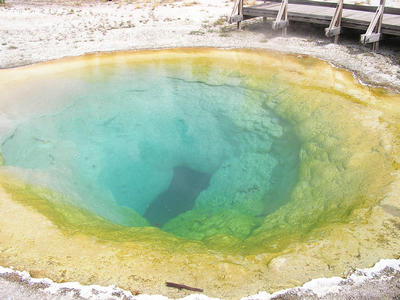
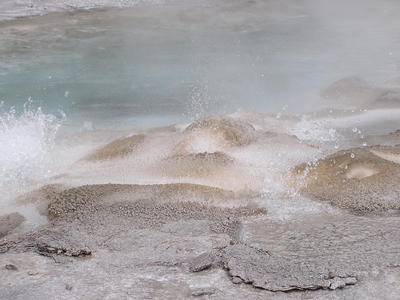 |
Aug 9th
After breakfast, finally into the park. Based on my previous experiences, the
Old Faithful area is really the best place to start looking at thermal features,
so we skip the other basins along the way. We do stop to look at several elk
grazing in the Madison River valley. Yellowstone is big, about three times
the size of Rhode Island, and we get to Old Faithful in about an hour, just
in time for an eruption. When I was a kid, it erupted every hour or so, but
earthquakes
in 1959 and 1983 along with other changes have stretched it
out to 92 minutes on average. While Old Faithful is the most important
geyser in the park, it's not my favorite feature. It's in the
large Upper Geyser
Basin and a boardwalk take people by dozens of other geysers and hot springs.
Morning Glory Pool used to be one of my favorites, but despite efforts to
clear the spring of some of the coins, bottles, and other debris that was
reducing water flow, I think it's still a little cooler than in 1974 and
not quite as pretty. Crested pool is neat, blobs of superheated water drift
up and burst into steam near the surface. Sometimes in the center, sometimes
at the edges, sometimes it's quiet. Hannah likes Spasmodic Geyser which is
really a small group and always busy making splashes at random. We see
Daisy Geyser erupt from a distance while on a ranger-led tour and Old
Faithful erupts again.
|
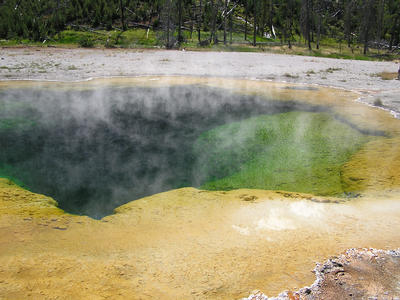
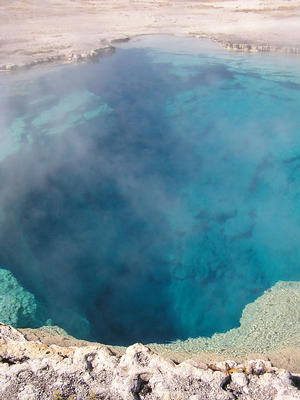
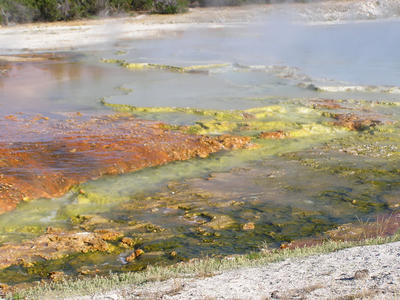
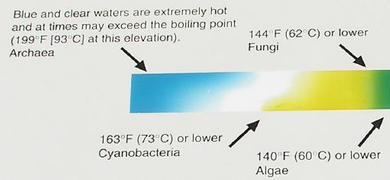
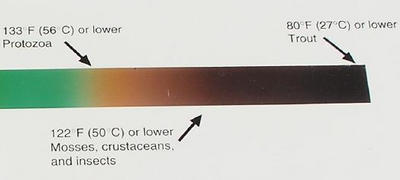
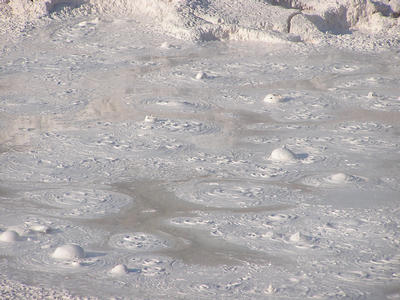 |
When we arrived the parking lots were almost empty. We leave after watching
another Old Faithful eruption and what a change - it feels like leaving some
sporting event or concert, but we finally make it out. It's late enough that
we decide work our way back instead of crossing the mountains to the Lake,
and visit Black Sands Basin (very nice springs, especially Emerald and
Sapphire - I had forgotten wonderful color of the latter, maybe it's improved
with age), Midway, Grand Prismatic Spring, the Fountain Paint Pots and a
couple others.
|
Back in West Yellowstone, Paula and Hannah look for ice cream for dinner
and I wander around looking for, well, I don't know what I want until I see
a barbeque sandwich place. Right size and right substance. I also find
the "Rare Earth" store with some decent rock samples and sculptures and a
(mostly) used book store with good past and recent Yellowstone material.
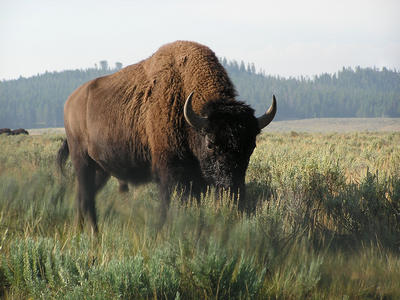
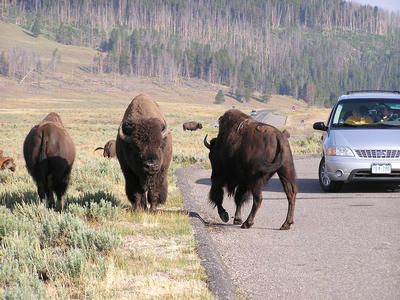 |
Aug 10th
Today we first head out to the Hayden valley where the Yellowstone River
flows after leaving the lake. We heard there were bison there from the ranger
yesterday. Getting there could be done with a loop around Old Faithful, but
we go the other way past the Norris Geyser Basin and then Canyon village
and the big waterfalls of the Yellowstone River up to the broad valley
between falls and lake. The reports were more than accurate - there were
bison to the left, bison to the right, and bison standing on the road. It's
bad enough that drivers stop in the middle of the road when some large mammal
is nearby, but they usually move or you can drive around them. Bison are
less predictable and have all the time in the world. However, grazing on
the road is pretty poor so they don't have any reason to hang around all these
weird machines and gawkers so they eventually move on.
Further up the road is another small herd. I also notice a couple Trimble
GPS receivers. I suspect they may be to provide reference data for tracking
radio collared animals with their own GPS receivers, but they could be looking
for signs of volcanic activity too.
|
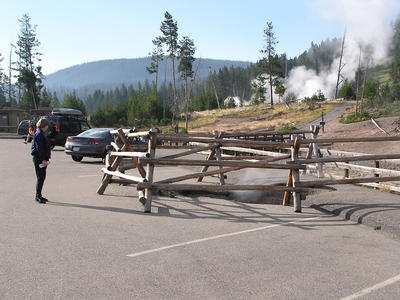 |
We're close to the Mud Volcano area where I intended to go yesterday
after Old Faithful so we stop today. One big feature there, the Black Dragon
Cauldron, emerged in 1948 and I wanted to see how it had changed. I'd already
heard of other sizable changes, most amusing are a couple features that
recently appeared on the edge of the parking area. They're reminiscent of
the software engineers' pilgrimage site, the
LaBrea tar pits at the Page Museum in Los
Angeles where new tar pits have consumed some of the parking there.
The Cauldron moved 200' from where it first emerged to where I saw it in
1974. It doesn't appear to have moved much since then, and the water has
much less mud than it used to. Still, it's an interesting area overall.
And smelliest. In 1974 I lived in Pittsburgh PA when the
steel mills were still active. The sulphurous smell reminded me of home.
|
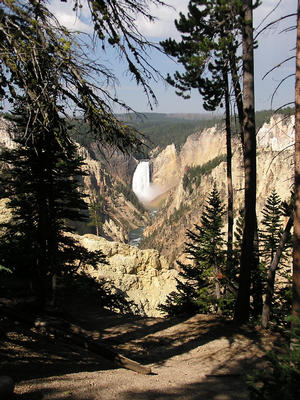
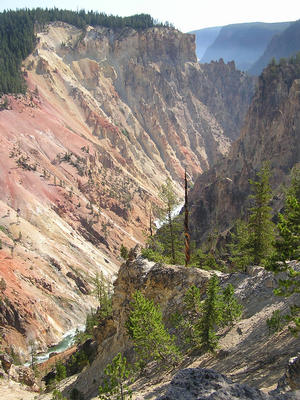 |
The features most people associate with Yellowstone, Old Faithful Geyser
and the waterfalls on the Yellowstone River, are not my favorites. You
can't get close enough to Old Faithful to see the steam trails from
single water droplets, and the easy views of the falls are from the top
instead of from the bottom. The view from a distance is more interesting
because you can see the Grand Canyon of the Yellowstone and there is greater
variety in canyons than there is in waterfalls.
|
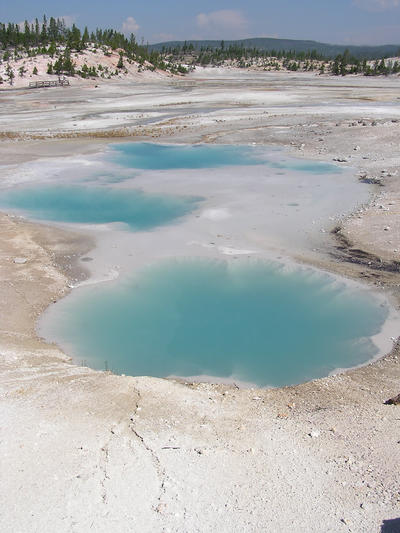
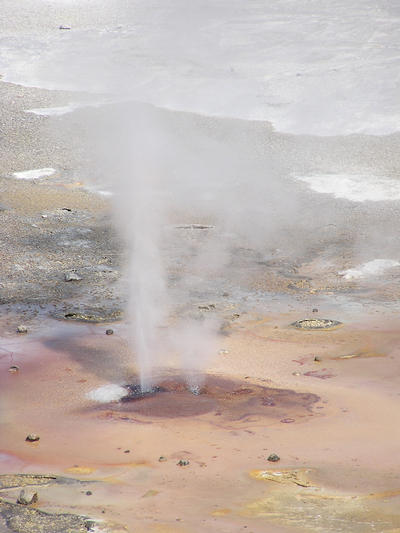 |
From there back through the bison and to Norris Geyser Basin, which is
even more changeable than the Mud Volcano area. In fact, more than half of
the basin's trails are closed because the ground temperature over the area
has soared to near boiling. A ranger taking temperature measurements even
blistered his feet through his boots while making a reading. That and a
bulge under part of Yellowstone Lake triggered a headline in the Bozeman
paper a couple days ago "Is Yellowstone Ready to Blow?" That's a little
premature, but it will happen someday.
I expected that Norris would be an interesting place, but I found
it not so. The energy and heat of the basin is is obvious, even in the
open area. However, things are so hot that the life that brings the
color to the other basins is nearly nonexistant. The lack of life and
things like these energetic steam plumes left me feeling distinctly
uneasy. It was almost a relief to leave and head north to Mammoth
Hot Springs.
|
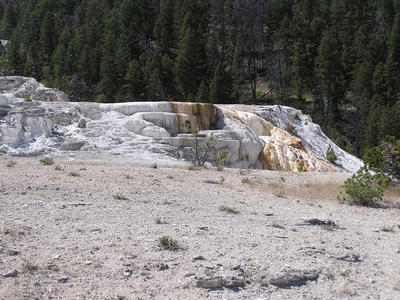
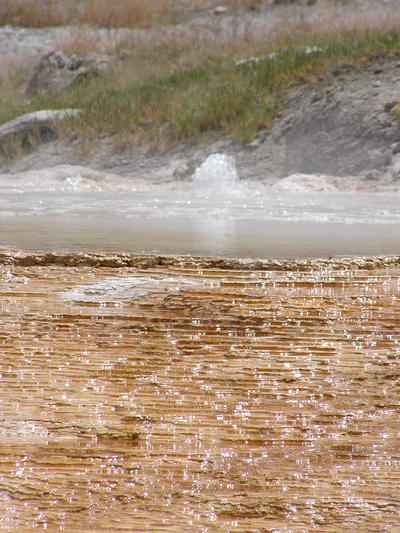 |
While Norris is the most acidic basin, Mammoth Hot
Springs is the least acidic. The others generally work with dissolved
silca and lay down a mineral called sinter or geyserite. Mammoth has
carbonate rocks, and is sort of an inside-out limestone cave. It's
big, but mostly dry. Only a couple areas have water flowing over the
rocks, not quite what I expected, but interesting nonetheless.
|
Mammoth
is also at the northwest corner of the park and also the lowest point,
and that's where park headquarters are located. We leave that way, go
through Gardiner and head north to I90. We make a brief stop in Bozeman,
where I fail to find the computer museum I saw on a map. I find the map
while we're eating a snack, but it's after 5 PM and I figure there's no
chance that it's open. Then back through Butte and roll into Missoula
after dark. The air is smoky - several fires were started by thunderstorms
over the last few days and some are pretty big.
Aug 11th
Returned the car this AM (hey - there's some ash on the windshield!), bike
along the riverfront parks back to the Internet cafe that seems to be the
best place to update WWW pages. We'll stay in town overnight and head out
tomorrow for Great Falls, a few days ride from here.
The chronicle continues with the Montana page.
Other links:
index page and overview
Paula's page
Ric's page
Hannah's page
















